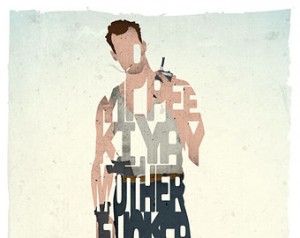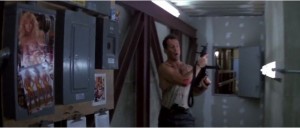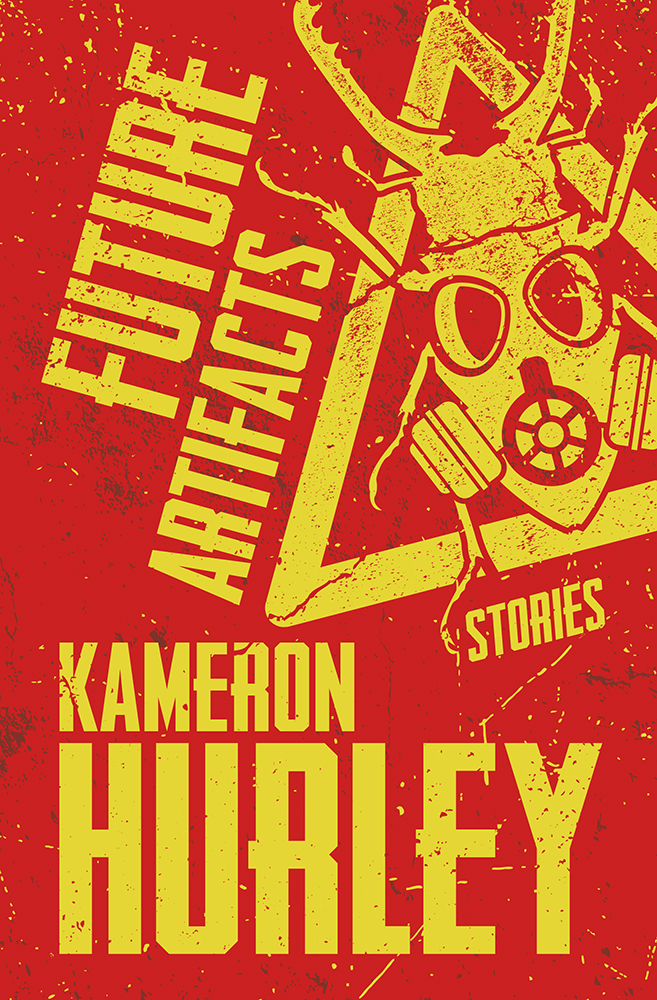I watch Die Hard at least a couple of times a year; it’s one of the best written films out there. But there were always two moments in the film that confounded me from the very start, even when I watched it as a kid. There’s a moment when John McClane is upstairs in the floors under construction, and he’s trying to figure out how to get the attention of the police even though the phone lines are cut. During this high tension scene, the camera’s attention swoops with John’s to the building across the way, where a naked woman is talking on the phone, and the camera holds there for a few seconds while he watches her, open mouthed. Right after this moment, he hits the fire alarm to call the authorities, so I figured that somehow this scene was meant to show us his thought processes – hey, other people in the buildings next door have phones. What other way do we have to communicate? – in addition to being a general male-gazey moment for the audience.
But on actually reading the script recently, I found that this scene was in fact meant to be nothing more than what it is – John checking out a naked lady on the phone in the next building. It wasn’t supposed to lead to some other revelation. It wasn’t the bridge scene between “what do I do?” and “pull the fire alarm.”
It was just a dude watching a naked woman.
There’s another interesting moment that happens as McClane is running around the rooftop of the building. At one point he cuts through a locker room, and there’s a Playboy pin-up on the wall. He is literally being chased by people with guns, and he slows down and takes a moment to appreciate the pin-up. Later, he goes so far as to pat the pin-up again- for luck, presumably? – as his situation continues to deteriorate.
Die Hard is an 80’s movie, one with a core emotional conflict that centered on real social change happening at the time – women moving into executive positions who had begun out-earning their husbands. Where was the place for men, in a world like that? How did you define being a man, when it wasn’t through being a bread-winner? What does it mean to be a dude when there are no more monsters to fight and your wife is a CEO?
This is where the film doubles-down on John McClane’s masculinity. Not only is he a tough cop with the skills to protect his wife from “real” danger (as opposed to corporate mergers), but he’s a red-blooded type of man with a healthy, lusty drive for women. He is not, the film insists, hen-pecked or submissive or cuckolded or de-manned in any way by his financially more powerful wife. These little nods – however odd, within the context of the actual narrative – which is a dude being chased through a tower by terrorists – showing him participating in the “normal” objectification of women are meant, I think, to be reassuring.
Weirdly.
Just as a soldier in WWII would paint a lusty pin-up on his plane, or have it folded up in his jacket, McClane both acknowledges and pats his own, for luck. She is not meant to be a real person, of course. The real person, the problematic, complicated person, is his wife. The pin-up is the easy stand-in; something easily controlled, always there; reassuring. They are objectifications of people. People who can be owned and called upon whenever the viewer needs them. They exist as things, and they exist primarily for one purpose.
It turns out that the other Playboy playmate featured in the film is the one who shows up topless in the film, interrupted as she and a colleague are getting it on in a spare office.
Color me unsurprised when I learned that bit of trivia.
The playmates had their one purpose.
Context is important when we choose to make a piece of art. Knowing and understanding how our piece of art will be read or viewed within the historical context of other pieces of art is vital to both understanding how others will read it and formulating the defense of our choice despite that context. As someone who wrote a very violent series of novels featuring a cast of characters who use Arabic words on occasion, I’m pretty familiar with the importance of this process.
Context, or lack, thereof, was one of the reasons I found the notion of the literary pin-up calendars the last few years really noxious and depressing. Because despite the many posts I would see from folks defending them (folks hopping in and feeling there was a need to defend them, before they’d even been made, spoke volumes right off the bat), and the fact that the latest one was, in fact, in support of Clarion, the project wasn’t going to escape being seen within the history of the pin-up. No matter how much everyone wished it.
And that’s what I saw. How those images have been used, by whom, and for what purpose.
But I avoided the discussion around it at the time, because wasn’t it obvious? Was it really worth my spoons?
The “pin-up” dates back to the late 1800’s, and was a form of marketing used for dancers and actresses. It’s interpreted by some as a rather rebellious act, flying in the face of Victorian sensibilities related to women’s place in the home, as opposed to in the public sphere. But it was not always the actress or dancer herself who created them, and as much as folks want to hang a hat on this as being somehow “empowering” I’ll note that it is, in fact, just a form of marketing. It was actresses and dancers all dolled up, looking their best, selling their performances based on their charming good looks; much of it just as stuffed, primped, and polished up as the worst Photoshop of our day. The pin-up was problematic already upon its inception, as they certainly would have been reminiscent of pornography; after all, if you were gussied up as a man, what other women besides ones’ wife was one actually supposed to gawk at in this medium?
Faking bodily perfection – in particular among women – has a long and sordid history, too. Did you know women in ancient Athens actually stuffed their clothes so they looked like they had bigger breasts and butts? They bound and smoothed flabby bodies. They wore wigs when necessary. They faked it.
But why? Why all the faking? Why did women have to look perfect in person, or at least perfect in the marketed pin-up?
Because women, in many cultures – and in the history of many cultures – are seen as commodities. As objects. Their worth is measured in beauty. Whether you’re selling me your idealized form yourself or someone else is doing it, the sad fact is that pushing these types of fake bullshit on us is part of a larger history of commoditizing people. And yes, blah-blah people can be sexy in many! Different! Ways! – yes, that’s wonderful. People are sexy. But *this* type of representation of “sexy” doesn’t look like actual bed-time sexiness any more than your typical porn movie actually looks like you and your partner(s) getting it on.
It’s a trick. It’s marketing. It’s meant to be toxic, and create an unfulfilled desire – for you to want, or to want to aspire to – that only the object can fulfill.
Of course, people have fucked and procreated quite happily, full of imperfections, for hundreds of thousands of years. But we are less good at celebrating that, or simply accepting it, than we are at rubbing away people’s flaws and turning them into rock-god heroes we can all pretend we own, or pretend can be bought. Because there’s not a lot of money in telling everyone they’re attractive just as they are, or that a woman is not a thing one can own to soothe one’s problems. People still want to believe there are women, in particular, who will serve all their wants and needs and give up being a complicated company CEO in order to do it.
This is really what the pin-up is about. It’s about ownership. Inciting desire. Making people think they can own a thing by going out and seeing the actress at work, or hiring her for a show. It’s selling the desire for ownership.
After coming off a long period researching slavery in antiquity for my new series, it’s very difficult for me to go all rah-rah empowerment when I see folks trying to make perfection and/or subservience sexy. There’s too much horrifying history behind that.
Rah-rah empowerment of this sort reminds me of the story of a “freed” woman in Athens, a former prostitute, whose “freedom” was actually bought by two men, two of her most ardent suitors. As lovely as it would be to think these folks had some kind of happy polyamorous union, or that they did this out of True Love, on reading the accounts of this particular transaction, she continued sleeping with them both from time to time (not living with them, but occasionally visiting them to have sex) because they effectively owned her; she was in debt to them. So she was “free” sure, but only free from being forced to have sex with a lot of people instead of just these two people. And oh, sure, it could indeed be more complicated than that. Stockholm’s syndrome, and all that. We often find ourselves in love with our oppressors, because otherwise we’d go mad. Maybe she even genuinely liked them. Maybe they liked her too, though I suspect that if that was the case, one of them would have married her, or helped her make a good living outside of fucking them.
This actually happened a lot in antiquity – men buying the “freedom” of a woman (and other men) and then continuing to have sex with them, only for “free.” It creeped the ever-loving fuck out of me, as much of my research about Athens did, because as much as the U.S. school system holds up Athens as some kind of modern utopia, the truth is the top 1% of people were ruling over a vast, stratified society of people in various states of enslavement.
It’s creepy as all get-out, these varying levels of body-ownership.
And in this society of enslavement and subservience, in a culture of people as things, courtesans and hetaera and the like also understood the importance of marketing. It’s why they faked their looks with cosmetics and sewn-up hair, and plush butts. Because they knew they were only as valuable as their perceived worth as sexual objects, or, at least, desirable objects that the 1% could fight over.
I hadn’t much thought about the annoying literary pin-up calendars in a while – not since January, when Justin at Staffer’s Book Review brought it up again as being intensely problematic. As I told Justin at the time, it was one of those low-level annoyances I’ve learned to live with over the years. I try to save my ire for the truly egregious things these days. I only have so many spoons.
But this morning I clicked through to a link of a woman who’d undergone surgeries for three types of cancers. With clothes on, from the neck up, you’d assume she had the form of some privileged person, and of course, with clothes on, and with her thin frame and symmetrical features, she does likely enjoy a lot of privilege out in the big bad world.
But what she’d actually done is take her clothes off, not to be pin-up sexy, but to be real about what bodies which have survived three types of cancer actually look like. She’d had reconstructive surgery on her breasts, which were missing nipples. There was a broad scar across her belly from her hysterectomy. More scars on her legs, her arms; there was loose, stretched skin from rapid weight loss related to her illness. And though her face was carefully made up as any pin-up’s would be, her body showed us a much realer picture; her body carried the record of what she’d been through. Hers was the body of a person who’d been through the shit and survived it, not a body we were invited to own.
It was in staring at that picture that I became angry again at the idea that pin-up calendars were being used to support literary foundations. Because it was in that moment that the whole complicated hand-wringing I’d seen so many do in support of the calendar just fell apart for me.
We are selling fantasies.
As fantasists, as fiction writers, we sell fantasy. I get that. But fantasy is not bodies. It’s stories. What we sell does not have to be in service to narrative of objectification.
I don’t sell stories about perfect people you can stack neatly on a shelf, anyway. I’d argue few writers actually do. I present flawed, angry, battered, busted, messed-up people who aren’t here to be your fucking friends. They’re not here to fulfill your desires. They are not here to be looked at, or owned. In truth, when I write “the end” I strive to ensure that all of my characters have a life that’s going on beyond that last page, a life you might think about sometimes; you might wonder what they’re up to. But it’s not a life you own, any more than you own mine. It’s a life you get to participate in for a while, maybe. But then they go home, and you go home.
When I started to try and figure out what a pin-up calendar of characters from my books would look like, I came up a blank, because my characters aren’t selling their bodies. They aren’t meant to be singular sexual objects, or actresses (or actors). They’re meant to be people. People who aren’t owned.
What you’d end up with is something like Nyx sitting on the toilet, belly fat spilling out, ragged scars up her thighs, hairy legs splayed, spitting sen on the floor from a bruised mouth. She’d be sitting there with mismatched skin lined in scars and stretch marks and maybe paging through some boxing magazine, fuck-it-all-not-interested in you, flabby breasts unbound and spilling onto her stomach. And she could give a fuck about you. She’s not interested in you, or your problems, or patting you on the head, or giving you some bit of happy luck when you throw yourself from a rooftop crawling with German terrorists.
And that’s just the one who doesn’t give a toss for being naked. There are a million other characters who would spit in your face before posing as objects, to be drawn out and commoditized; it would mean rejecting everything they were, everything they believed in, to pose as some perfect, pawed-over item in a stranger’s inventory. I tried to imagine Lilia, the primary protagonist in my new series, with her scarred face and clawed hand and bum leg, whose entire existence has been within in a consent culture where people retain absolute autonomy over themselves and their bodies and their desires, getting pitched this idea, and I could just imagine her screwing up her face like, “You want what?” 
Because make no mistake – pin-ups are created to cash in on the desires of others, from the very start. They are a marketing medium. They are meant to sell us idealized fantasy, perfect objects, things, and they do this by presenting people the same way we would a sexy new dishwasher or succulent browned duck ready for the eating. “Here is something you can own,” we say. “Something just for you.”
And the bodies we present to them are flawless objects, beautifully rendered.
Own this. Be this. Do this.
But I’m not selling bodies. I’m selling stories.
Stories.
And, just like that, after looking at that image this morning, I saw all the calendars we prop up, the calendars we go through such squirrelly mindfucking double-think to make “OK” and empowering, and all about sexy-sexy take-control-of-the-narrative actually became, quite quickly, quite simply, and quite easily, just another part of a fucked narrative. Just another example of presenting flawless bodies for easy consumption – instead of stories.
For all the back-bending work we do to defend our problematic choices, sometimes we’re not actually working out how to save the world, or stop sexism, or empower women with pole dancing.
Sometimes all we’re really doing is being a dude watching a naked woman in the next building, biding our time until the next plot token arrives.


